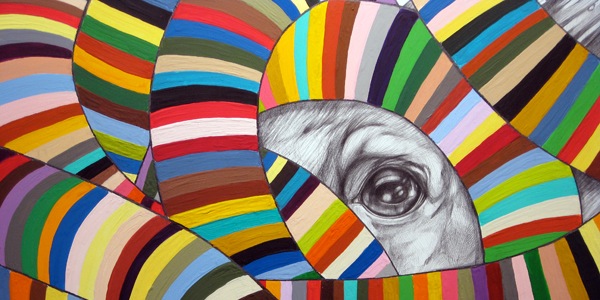
Claton Porter untitled (deer head) 2010
Clayton Porter’s “Deer Hart, Dog Dick” Opens at LAUNCHPROJECTS
A prominent thinker on ecological economics, Nate Hagens, explains consumerism in terms of evolutionary biology and evolutionary psychology, saying that our brains send out “shots” of dopamine (a reward chemical, which makes us feel good) when we decide to have a cigarette, buy another pair of shoes, or eat more ice cream. This biochemical response, which was once crucial to our survival (as in, motivating us to kill an antelope for dinner), has resulted in our collective overindulgence. The important thing about this neurological response is that the dopamine is released when we make the decision to buy the shoes, not when we actually have the shoes, which keeps us consuming more to produce the same reward in our brain. This explains why we are on a “hedonic treadmill” at present, and planetary resources are in decline.

Clayton Porter "untitled (self portrait)" 2010 60 x 48 inches graphite and acrylic on panel
If Hagens ideas about evolutionary psychology took artistic form, they would resemble the creatures in Clayton Porters paintings and drawings. Recently, I visited Porters studio to review his newest body of work, which he is preparing for an exhibition, titled, “Deer Hart, Dog Dick” opening at LAUNCHPROJECTS July 8th in Santa Fe, New Mexico. Porter has co-opted certain symbols to assist him in his story of human desire: deer, dog, monster and human. As if by feasting on the flesh of humans, Porters monsters grow larger. I compare this to the hedonic treadmill, and our desires growing ever larger despite having won the kill. Nothing can satiate our wanting appetite, Porters work presumes. Hagens research and the current state of our nation verify this fact.
I point to a favorite among Porters latest body of work, his self-portrait (Untitled, Self Portrait). It reminds me of Porters ability to bring the viewer so close to him, and supposes that the artist himself has struggled with the seductive mistress-desire, only to be suffocated, as the painting suggests, by his yearnings. Porters self-portrait underscores the misery of ardor, similar to Boschs damnation. Addictions to sex, food, or money are ugly and messy, and are deadly sins according to the Bible. Ecological economists like Hagens would add to this list, saying that our country is “addicted to oil” (and, this has certainly become quite messy). Our overindulgence in stuff is killing our planet. From a psychological perspective, Porters self-portrait suffers for his desires, which depicts a man with deer horns, and a face completely obscured by tumors.
Porters impeccable, technical ability to convey his fantasies as if lucid reality, make this story of psychological damnation doubly compelling. Rubens, or Titian-like forms are perfected in his drawings-generous, muscular figures splay across the canvas insinuating movement, and peril. His art has a postmodern attitude, but is classical in its execution. Boschs famous “The Garden of Earthly Delights,” comes to mind-featuring humanitys damnation, after Adam and Eve ate of the forbidden fruit. Porters drawings warn against overindulgence like Bosch, suggesting that succumbing to the breadth of our desires leads to unpleasant cancerous growths overtaking our human face, or a loss of our humanity altogether as we become monstrous iterations of ourselves enslaved by our own appetites.

Clayton Porter "Untitled (dog dick)" 2010 Acrylic and Graphite on Panel. 30" x 42" x 2 3/4"
Considering the morbid implications of Porters work, I look to his past. Porter lost his Spanish Catholic mother when he was just 19 years old, in college pursuing his degree in art at the College of Santa Fe. He re tells the story of his mothers death through his art-quite profoundly. Porter recomposed his mothers image with what might have been left after her body decomposed, her teeth. Another piece re-imaged her body as X-rayed bones. Although this insight and depth might startle most teenagers, for Porter it proved cathartic. And, perhaps, there is some religious connotation here, with the reverence of mother being like Mary. Metaphorically, Porter venerated her body, and prepared it for heaven. Porter told me once that he would attempt to stay awake for seven consecutive days, despite the inevitable psychic anguish, if doing so would promise that he would then live forever (as in the Epic of Gilgamesh). I suppose the artists obsession with living has to do with losing his mother, who was an important figure for Porter. Reflecting on his latest body of work, I question if immortality might finally satisfy the artists desires.
Boldness is an understatement -“Deer Hart, Dog Dick” is a success for the artist. Porters work is courageous with resounding clarity of vision and ferocity of appetite. Buddhists might disagree with the following statement, but whatever are the negative implications of desire, the hedonic treadmill keeps us humans motivated to live somehow. After all, whats life without some ravenous pleasure?
(top photo: detail of Clayton Porters untitled (deer head) 2010 48 x 36 inches graphite and acrylic on panel)
